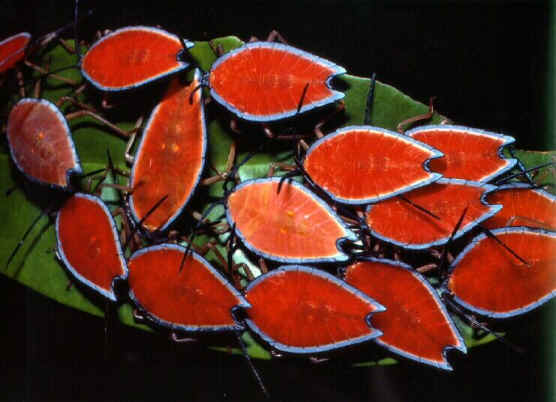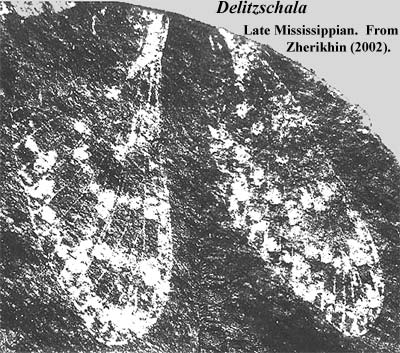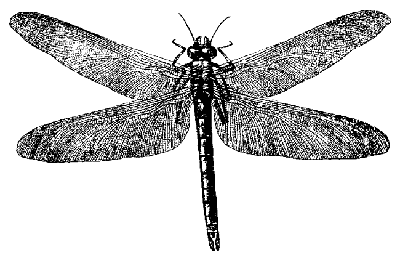
| Palaeos |  |
Insecta |
| Arthropoda | Insecta |
| Page Back: Home | Unit Up: Arthropoda | Unit Home | Clade Up: Hexapoda | Page Next: Insecta (2) |
| Unit Back: Home | Clade Down: Pterygota | Dendrogram | References | Unit Next: Pterygota |
|
Abbreviated Dendrogram
HEXAPODA | `--INSECTA (insects) |--Archaeognatha `--+--Monura `--+--Thysanura `--PTERYGOTA |
Contents
Overview |
 One of the most extraordinary groups of living organisms,
insects account for many more species than all other groups of animals and plants combined. Although there are more than 800,000 known species, this is believed to be only a small fraction of total, which may run as high as ten million or more. Add to this
innumerable species from Earth's past ages (only a tiny fraction of which have left any fossil remain) and one might guess that the number of species that have ever lived on Earth, past and present, may well amount to a billion (a thousand million).
One of the most extraordinary groups of living organisms,
insects account for many more species than all other groups of animals and plants combined. Although there are more than 800,000 known species, this is believed to be only a small fraction of total, which may run as high as ten million or more. Add to this
innumerable species from Earth's past ages (only a tiny fraction of which have left any fossil remain) and one might guess that the number of species that have ever lived on Earth, past and present, may well amount to a billion (a thousand million).
Insects include among their number parasites, parasitoids, carnivores, herbivores, scavengers, and detritivores. As adaptations to different food different types of insects are distinguished by any of several types of mouthparts - chewing, sucking etc. Finally, all more advanced insects go through a metamorphosis of some kind. This may be a partial metamorphosis (Hemimetabolous) in the case of the exopterygotan insects, or a complete metamorphosis (Holometabolous) in the case of the endopterygotan insects
Insects, both in the strict sense of Class Insecta and the broader sense of Superclass Hexapoda ("six-legged") - are characterized by having three tagmata - that is, a body divided into head, thorax, and abdomen - and three pairs of legs on thorax.
Text Creative Commons Attribution M Alan Kazlev 2002
|
|
The very basic external anatomy of insects is all we're going to cover here, and most of the information is in the image above. The head has a single pair of antennae (Crustacea, in contrast, are distinguished by possession of two pairs), and a pair of compound eyes. Compound eyes - a common arthropod feature - differ from vertebrate eyes in that, instead of a single lens, each eye has a large number of small lenses, around 4,000 in the case of the common fly. While not good for seeing precisely at long distances, compound eyes are very good at detecting movement. Between the compound eyes are usually three simple eyes, or ocelli. The head also contains the mouth and jaws which we will take up elsewhere. It is worth noting that most of the basal insects have mouths which are prognathous. The mouth faces forward here at the root of the insect tree. More derived insect have hypognathous, or downward- facing, mouths. Any of the major mouth parts may develop grasping palps.
The middle part of the body, the thorax, contains the three pairs of legs. Insects have fewer legs than any other arthropod. Depending on the adaptation and lifestyle, the legs are used for walking, swimming, jumping or digging. The overall structure of the thoracic legs is described in the figure of Thermobia. In addition to the pretarsus, tarsus, tibia and femur, insects have two proximal (closer to the body) segments not shown in the figure. These are the trochanter, which acts as a swivel joint for the leg, and the coxa, which anchors the leg to the body. Each of the thoracic and abdominal segments has an upper plate (tergum) and lower plate (sternum). The region which joins them is called the pleuron. It is pierced with openings (spiracles) for the insect respiratory system.
In most insects (the Pterygota) the thorax posses one or two pairs of wings for flying. The wings are lost in some groups - e.g. fleas. In the very primitive insects discussed on this page, wings did not evolve.
The abdomen is distinguished by 11 segments, and contains the main body organs, such as the heart, respiratory system, digestive system and reproductive system. The Parainsecta (springtails and proturans) and Diplura (diplurans) are not true insects, for their numbers of abdominal segments vary. These basal Hexapoda are not true insects. Thus, you will note, Insecta is an apomorphy-based definition. That is, it is defined by physical characteristics allegedly shared uniquely by this group. See cladograms.
ATW041013. Text public domain. No rights reserved.
 The earliest known
proto-insects were tiny wingless forms from the Early
Devonian, perhaps somewhere near the paleoequator. Eskov
(2002). The best known Devonian forms are the archaic collembellan (springtail),
Rhyniella praecursor. The first true insect may be Rhyniognatha
praecursor from the Early Devonian (Pragian)
of the Rhynie Chert.
However, insects remained very rare and marginal members of the terrestrial
fauna through the Mississippian.
The arthropod communities were dominated by arachnids and myriapod-like
animals Zherikhin (2002).
These earliest insect species were probably detritivores, scavenging for organic matter in the
thin soils of the time, although some species may have been herbivores feeding on live plants. It is almost certain
that detritivory appeared first. Zherikhin (2002). Most earlier
insects, to the extent they fed on living plants at all, seem to have been
specialist feeders on pollen or other enriched plant products. It is only
recently that true insect herbivory - leaf-eating -- has been securely
documented in the Jurassic, although this mode of life presumably developed
earlier. Rasnitsyn
& Krassilov (2000).
The earliest known
proto-insects were tiny wingless forms from the Early
Devonian, perhaps somewhere near the paleoequator. Eskov
(2002). The best known Devonian forms are the archaic collembellan (springtail),
Rhyniella praecursor. The first true insect may be Rhyniognatha
praecursor from the Early Devonian (Pragian)
of the Rhynie Chert.
However, insects remained very rare and marginal members of the terrestrial
fauna through the Mississippian.
The arthropod communities were dominated by arachnids and myriapod-like
animals Zherikhin (2002).
These earliest insect species were probably detritivores, scavenging for organic matter in the
thin soils of the time, although some species may have been herbivores feeding on live plants. It is almost certain
that detritivory appeared first. Zherikhin (2002). Most earlier
insects, to the extent they fed on living plants at all, seem to have been
specialist feeders on pollen or other enriched plant products. It is only
recently that true insect herbivory - leaf-eating -- has been securely
documented in the Jurassic, although this mode of life presumably developed
earlier. Rasnitsyn
& Krassilov (2000).
Insect flight developed suddenly during the Middle Carboniferous -- in the latest Serpukhovian/earliest Bashkirian. The evolutionary radiation of winged insects was a dramatic, exponential event, like the origin of multi-celled animals (Metazoa) at the base of the Cambrian, which only took about five million years. It is unlikely that winged insects existed during the mid Serpukhovian or the late Viséan Age, as none have been found at high preservation sites like Dora in Scotland. The tropical Euramerican province seems to have become a factory of insect diversity in the Carboniferous. All fifteen insect orders known from the Carboniferous are first known from Euramerica, a pattern that continued into the Permian. Eskov (2002).

The Permian period saw the continuation of all the Carboniferous types, plus a number of important new forms. The Palaeopterans continued to be well-represented, the blattoid and orthopteroid orders attained their greatest diversity, and new groups like the Psocoptera, homopteran Hemiptera, Mecoptera and Coleoptera, were all abundant and diverse.
But hard times were ahead. The Permian extinction events took out at least nine orders of insects, and the Mesozoic saw the decline and extinction of many more of the Permo-Carboniferous lineages. On the other hand, there was diverse evolution within the surviving orders, the Neuroptera, Mecoptera, and Diptera, and Coleoptera being notable examples. Many suborders and families were established, many of which survive to this day. In contrast to the Permo-Carboniferous pattern of evolution, the Triassic spike in diversity was diffuse, with new types of insect developing simultaneously in widely-separated locations. During most of the later Mesozoic, the pattern actually reversed, with most new taxa appearing first in cooler climates. Eskov (2002).
From the Late Cretaceous, and even more so the early Cenozoic period, insects were essentially of modern type. This is illustrated by the many Recent families and genera that have been found preserved in Baltic amber and elsewhere. Of the orders recorded with certainty for the first time from Tertiary beds, the Strepsiptera and Siphonaptera may have been relatively late developments, but the others were probably more ancient.
Image: Meganuera monyi - order Meganisoptera a giant dragonfly (order Protodonata) wingspan 60 to 75 cm Carboniferous of Europe. Graphic from Modelování v paleontologii - Michal Rybka. (originally from Zittel & Eastman Text-Book of Paleontology 2nd ed. vol.1 1937 MacMillan & Co. London, p.809, fig.1567)
Text Creative Commons Attribution 2002 Alan Kazlev. Revised ATW041013.
Range: Early Devonian to Recent
Phylogeny:Hexapoda : (Protura + Collembola) + (Diplura + * : Archaeognatha + (Monura + (Thysanura + Pterygota))))
Characteristics: lack of musculature beyond the first segment of antenna; Johnston's organ in pedicel (second segment) of antenna (this organ is a collection of sensory cells that detect movement of the flagellum; a transverse bar forming the posterior tentorium inside the head; tarsi subsegmented; females with ovipositor formed by gonapophyses from segments 8 and 9; annulated, terminal filament extending out from end of segment 11 of abdomen (subsequently lost in most groups of insects) - Kristensen 1991, via Tree of Life - Insecta
Links Tree of Life, Encyclopedia of Life, Wikipedia; Insectclopedia - lots and lots of links, arranged by topic; Prehistoric Insects - notes on insects through the ages (the images don't load); Insects at Mikko's Phylogeny pages; Fossil Insects & Alternative Order Names; Cultural Entomology Digest MAK120516
| Page Back: Home | Unit Home | Page Top | Page Next: Insecta (2) |
checked ATW050602, MAK120516, all text ATW public domain. page last revised MAK120516; text by MAK Creative Commons Attribution